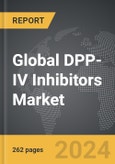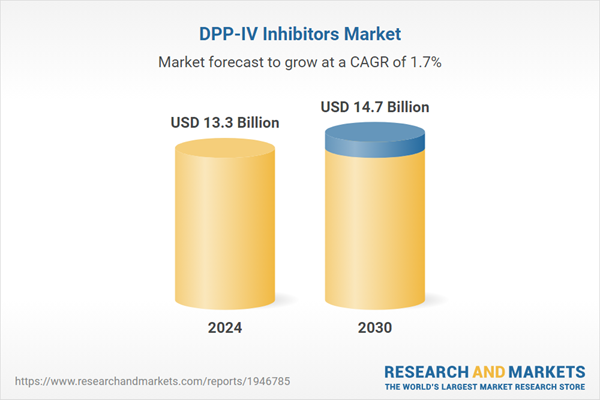DPP-IV Inhibitors - Key Trends and Drivers
Dipeptidyl peptidase-4 (DPP-IV) inhibitors are a class of oral hypoglycemic agents used to treat type 2 diabetes mellitus. These inhibitors work by blocking the DPP-IV enzyme, which is responsible for degrading incretin hormones such as glucagon-like peptide-1 (GLP-1). By inhibiting this enzyme, DPP-IV inhibitors increase the levels of incretin hormones, thereby enhancing the secretion of insulin in response to meals and reducing the release of glucagon. This dual action helps to lower blood glucose levels effectively. Commonly prescribed DPP-IV inhibitors include sitagliptin, saxagliptin, linagliptin, and alogliptin, which are typically used in combination with other antidiabetic medications or as monotherapy when other treatments are not suitable. These drugs have gained popularity due to their efficacy, relatively low risk of hypoglycemia, and oral administration, which is preferred by many patients over injectable therapies.Several trends and developments are influencing the DPP-IV inhibitors market. One significant trend is the increasing prevalence of type 2 diabetes globally, driven by factors such as aging populations, sedentary lifestyles, and rising obesity rates. This surge in diabetes cases is boosting demand for effective and convenient treatment options like DPP-IV inhibitors. Additionally, ongoing research and development are leading to the introduction of new and improved DPP-IV inhibitors with enhanced efficacy and safety profiles. Pharmaceutical companies are also exploring combination therapies that pair DPP-IV inhibitors with other antidiabetic drugs, such as sodium-glucose co-transporter-2 (SGLT-2) inhibitors and metformin, to provide more comprehensive blood sugar control. Furthermore, there is a growing emphasis on personalized medicine, where treatments are tailored to individual patient profiles based on genetic, environmental, and lifestyle factors. This approach is expected to optimize the effectiveness of DPP-IV inhibitors and minimize adverse effects.
The growth in the DPP-IV inhibitors market is driven by several factors. Technological advancements in drug discovery and development are enabling the creation of more potent and selective DPP-IV inhibitors, improving patient outcomes. The rising global prevalence of type 2 diabetes particularly in emerging economies is expanding the market for these medications. Increasing awareness about diabetes management and the importance of maintaining optimal blood glucose levels is encouraging more patients to seek treatment, boosting demand for DPP-IV inhibitors. Additionally, the convenience of oral administration and the relatively favorable side effect profile of DPP-IV inhibitors are driving their adoption among patients and healthcare providers. Strategic collaborations and partnerships among pharmaceutical companies are also fostering innovation and facilitating the introduction of new products to the market. Furthermore, supportive government policies and reimbursement frameworks in many countries are making these treatments more accessible to a broader patient population, thereby driving market growth.
Report Scope
The report analyzes the DPP-IV Inhibitors market, presented in terms of units. The analysis covers the key segments and geographic regions outlined below.Segments: Segment (DPP-IV Inhibitors).
Geographic Regions/Countries: World; United States; Canada; Japan; China; Europe (France; Germany; Italy; United Kingdom; and Rest of Europe); Asia-Pacific; Rest of World.
Regional Analysis
Gain insights into the U.S. market, valued at $3.5 Billion in 2024, and China, forecasted to grow at an impressive 1.7% CAGR to reach $2.4 Billion by 2030. Discover growth trends in other key regions, including Japan, Canada, Germany, and the Asia-Pacific.Why You Should Buy This Report:
- Detailed Market Analysis: Access a thorough analysis of the Global DPP-IV Inhibitors Market, covering all major geographic regions and market segments.
- Competitive Insights: Get an overview of the competitive landscape, including the market presence of major players across different geographies.
- Future Trends and Drivers: Understand the key trends and drivers shaping the future of the Global DPP-IV Inhibitors Market.
- Actionable Insights: Benefit from actionable insights that can help you identify new revenue opportunities and make strategic business decisions.
Key Questions Answered:
- How is the Global DPP-IV Inhibitors Market expected to evolve by 2030?
- What are the main drivers and restraints affecting the market?
- Which market segments will grow the most over the forecast period?
- How will market shares for different regions and segments change by 2030?
- Who are the leading players in the market, and what are their prospects?
Report Features:
- Comprehensive Market Data: Independent analysis of annual sales and market forecasts in US$ Million from 2024 to 2030.
- In-Depth Regional Analysis: Detailed insights into key markets, including the U.S., China, Japan, Canada, Europe, Asia-Pacific, Latin America, Middle East, and Africa.
- Company Profiles: Coverage of players such as AstraZeneca Plc., Boehringer Ingelheim GmbH, Eli Lilly and Company, Merck & Co. Inc., Mitsubishi Tanabe Pharma Corporation and more.
- Complimentary Updates: Receive free report updates for one year to keep you informed of the latest market developments.
Some of the 16 companies featured in this DPP-IV Inhibitors market report include:
- AstraZeneca Plc.
- Boehringer Ingelheim GmbH
- Eli Lilly and Company
- Merck & Co. Inc.
- Mitsubishi Tanabe Pharma Corporation
- Novartis AG
- Takeda Pharmaceutical Company Limited
Tariff Impact Analysis: Key Insights for 2025
Global tariff negotiations across 180+ countries are reshaping supply chains, costs, and competitiveness. This report reflects the latest developments as of April 2025 and incorporates forward-looking insights into the market outlook.The analysts continuously track trade developments worldwide, drawing insights from leading global economists and over 200 industry and policy institutions, including think tanks, trade organizations, and national economic advisory bodies. This intelligence is integrated into forecasting models to provide timely, data-driven analysis of emerging risks and opportunities.
What’s Included in This Edition:
- Tariff-adjusted market forecasts by region and segment
- Analysis of cost and supply chain implications by sourcing and trade exposure
- Strategic insights into geographic shifts
Buyers receive a free July 2025 update with:
- Finalized tariff impacts and new trade agreement effects
- Updated projections reflecting global sourcing and cost shifts
- Expanded country-specific coverage across the industry
Table of Contents
Companies Mentioned (Partial List)
A selection of companies mentioned in this report includes, but is not limited to:
- AstraZeneca Plc.
- Boehringer Ingelheim GmbH
- Eli Lilly and Company
- Merck & Co. Inc.
- Mitsubishi Tanabe Pharma Corporation
- Novartis AG
- Takeda Pharmaceutical Company Limited
Table Information
| Report Attribute | Details |
|---|---|
| No. of Pages | 262 |
| Published | April 2025 |
| Forecast Period | 2024 - 2030 |
| Estimated Market Value ( USD | $ 13.3 Billion |
| Forecasted Market Value ( USD | $ 14.7 Billion |
| Compound Annual Growth Rate | 1.7% |
| Regions Covered | Global |









